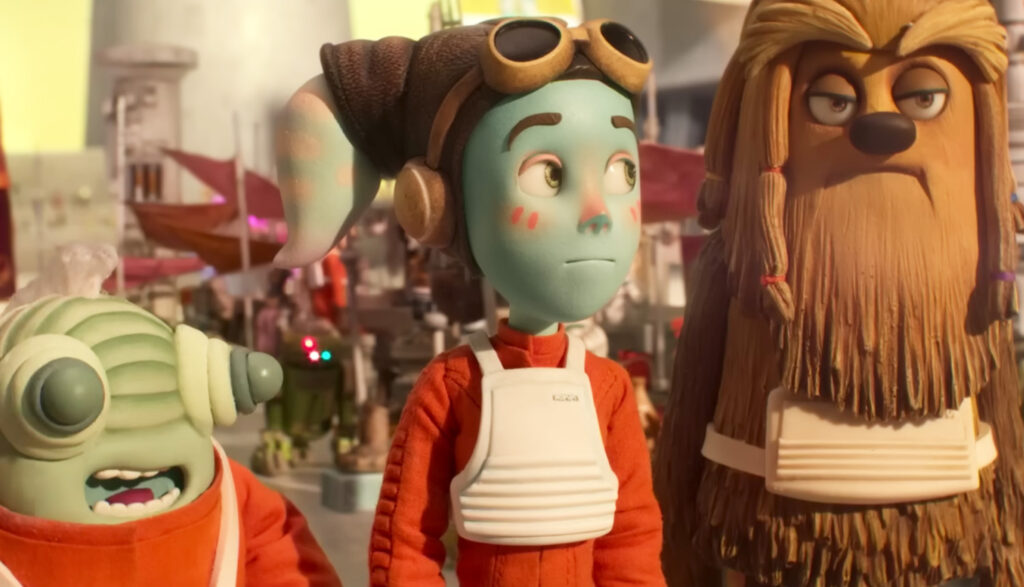
Dune: Prophecy
Language, violence and sexual content will make ‘Dune: Prophecy’ much less accessible to families than the films it’s based on.

The universe is expanding rapidly, scientists say.
I can’t speak to that myself, of course. I’m a television reviewer, not a scientist, and I don’t feel my literal universe expanding that much on a day-to-day basis.
But if our universe is anything like the Star Wars universe, we’d have to assume it’s expanding mighty fast. For example: Disney+’s Star Wars: Visions.
The stories unpacked in Visions won’t necessarily sidle into the official George Lucas/Disney canon. But it’s not nearly as speculative or as purposefully off-canon as, say, Marvel’s What If …? series (also on Disney+), either. It’s more like the world’s top animation studios were given a massive set of Star Wars building blocks and told to construct something totally Star Wars but utterly unique. It’s what would happen if Tatooine suddenly collided with, say, Dragon Ball Z.
The stars are literally the limit with each 15-minute episode of Visions. A mysterious man with a lightsaber might defend a small village from nasty troopers in one, offering a touch of Akira Kurosawa. A one-time Jedi Padawan might start a rock band with a cousin of Jabba the Hutt in another, playing a few notes of Bill & Ted. Each episode comes with its own artistic vision, too, embracing each studio’s individual aesthetic and eschewing (for the most part) cookie-cutter, 3D computer animation.
The second season, like the first, offers nine episodes, and you never know what sort of story might be in the offing. Which seems fitting, given that Star Wars literally gives us a whole galaxy of narrative possibilities.
But while each episode is different, all share some similarities, too. For the most part, these Star Wars offshoot tales feel like they’re made for older audiences—teens and young adults who love their anime and dig individualism in their animation. These are not necessarily the innocent cartoons that Disney typically peddles. (You can hear loads more about anime on one of our podcast episodes.) They can feel rougher, more mature and more violent at times.
Some stories can feel dark, others surprisingly ambiguous. (In Season Two, a young ingenue uses the Force in a nightmarish test and is whisked away by a mysterious mentor—but whether that mentor is Jedi or Sith is a tantalizing question.) Spirituality and the supernatural can be found in episodes, as well. (And certainly, the spiritual dualism that Lucas purposefully grafted into Star Wars is represented, too.)
But nothing seems to stray outside the bounds of the show’s TV-PG rating, either. This universe is largely devoid of bad language (with some notable exceptions). And while some animated garb can show a bit of animated skin, it’s far, far more restrained than, say, Princess Leia’s infamous slave outfit from Return of the Jedi.
I’d imagine Star Wars and anime share many fans. For them, of course, Star Wars: Visions is like a present from Admiral Akbar himself, all tied up in a bow. (“It’s a wrap!”, as he said in the LEGO Star Wars Holiday Special.) And for parents of young padawans, the show stands a chance at being navigable, too. Just be aware, even 2D lightsabers can do some pretty big damage.
An artist on a secluded planet wakes up from a nightmare and begins to do her day’s work. But her land is soon visited by three beings that wish to take her… back. The artist was once a Sith apprentice, and these visitors—her apparent master back in the day—want her to fulfill her promise.
The episode (created by El Guiri Studios) leans into the vaguely Eastern spiritual “balance” that’s been a part of the Star Wars canon from the get-go. Everything the artist touches turns to black for a moment, including her painting. And as much as she’d like to expunge the darkness, she can’t: “Light and darkness are a part of the painting—part of me,” she realizes. And it’s apparently in balancing the two that she can paradoxically escape the darkness that threatens to consume her.
The episode is also rather violent, with a couple of beings destroyed with extreme prejudice, and a cute little robot (which looks like part-Death Star with legs) having its limbs yanked off. One creepy-looking combatant is sliced via lightsaber and slowly dissolves into dust. Shots are fired, as well, and we see explosions.
Created by Cartoon Saloon, this episode takes us to a polluted, workhouse-like planet where a handful of laborers swipe speeders to go to the haunted Screecher’s Reach. But one—a girl named Daal—isn’t just going ghost hunting. She’s on a quest to find a new life for herself.
Daal wears a mysterious amulet that she almost seems to pray to or pray with. “I follow your path with strength and courage,” she says to it, an in moments she repeats it like a mantra. The amulet glows at times with supernatural power.
[Spoiler Warning] The enemy that she goes to face seems, at first, to be no less supernatural. The thing that haunts the Reach is a saber-wielding banshee, of sorts—a creature that will almost certainly terrify young viewers. (The monster seems altogether fitting, given Cartoon Saloon’s Irish roots; it’s the same studio that produced such lauded movies as The Secret of the Kells and Wolfwalkers.) But while the banshee can use the Force and even keens (the Irish term for the banshee’s shrill wailing), it proves to be mortal. The fight between Daal and the banshee is not bloody but fearsome indeed. Even when Daal defeats the monster, though, viewers are forced to ask whether this was a climactic challenge for a future Jedi or the first step on the way to Sithdom.
We hear Irish variations on “a–” twice. Characters steal speeders. We hear a bit of crude humor.
On a planet utterly decimated by the Empire, two sisters try to survive and remember their ancestors as best as they can. But when they run out of drinkable water, the oldest sibling must brave the Imperial facility that hordes it—and the younger decides to tag along.
Chile’s Punkrobot Studios created this Claymation adventure, and the sisters’ culture echoes the practices of indigenous peoples. They spray sparkling mushroom dust on rocks, outlining the sisters’ hands, and using it to paint pictures of their mother (who was “strong” in the Force, we’re told) and other long-gone relatives. The sisters believe that their mother and other ancestors are stars—but stars that can’t be seen anymore because of the thick clouds of pollution covering the planet. It’s suggested that when the girls are no longer able to paint (and the starlight can no longer illuminate their paintings), their connection to their mother and her supernatural world will be gone. The story comes with an environmental tang to it, as well.
The sisters ultimately fight Imperial guards and machines. We see an artistic flashback of sorts, telling us (without showing gory details) how their mother died. A deluge presumably kills many and destroys a great deal of property. The Force is used. People are shocked. Someone is nearly dropped from a dizzying height.
A mysterious stranger arrives on the outskirts of an isolated village just as its attacked by remnants of the Empire’s old army. And while the village can handle the stormtroopers just fine, it’s not prepared for the Sith (essentially an evil Jedi) who’s leading them.
The Sith uses a weapon that’s a cross between a lightsaber and a parasol, with the spokes serving as the blades. She uses it to skewer one defender (which we see), then spins it like a top to obliterate a laser gun (and presumably its owner, too, though that fatality takes place offscreen). Another victim is stabbed through the back, the lightsaber blade poking out through the chest. Dozens of other stormtroopers and a few villagers are mowed down through various means, and we see lifeless bodies lying on the ground.
What looks to be an Eastern religious idol features prominently in a showdown, and one combatant presses his hands together and bows toward the statue as if in respect and/or prayer. The Sith’s outfit is a wee bit revealing in this black-and-white, hand-drawn episode.
A motley collection of musicians play in a band called Star Raver, but they never get to finish a set because one of their members—a cousin of Jabba the Hutt—has a bounty on his head. “It’d be nice to finish a show for once,” lead singer (and former Jedi Padawan) Jay admits as they head to their next gig. But when Boba Fett finally tracks them down and takes the wayward Hutt into custody, Jay and his bandmates must decide whether to fight, hide or use music to save the day.
Instruments used by the members of Star Raver have some hidden offensive abilities, from throwing flames to sending out bolts of electricity. (Jay’s mic may also double as an on-the-fritz lightsaber, too.) We see lots of stormtroopers incapacitated by said instruments (and hear at least one or two scream). We hear threats invoking both disintegration and a more generic execution. Jabba eats a little critter. One of the band members looks like a devil. (Well, actually three devils, given that he has three different torsos.)
The rebuilding Empire has a couple of new leaders to contend with: twins genetically bred and raised to be the Dark Side’s answer to Luke and Leia. They’ve built a pair of conjoined Star Destroyers that can take out (you guessed it) a whole planet if the twins get the urge, but they’ll need to install a powerful kyber crystal to power the destroyers. But one of the twins—Karre—isn’t so sure he wants to be a member of the dark side after all.
The two fight and nearly kill each other. (A vision of sorts shows that Am, the other twin, does die.) Stormtroopers also fight and die, and scads of unseen casualties are likely caused by the destruction of at least one side of a massive spaceship.


Paul Asay has been part of the Plugged In staff since 2007, watching and reviewing roughly 15 quintillion movies and television shows. He’s written for a number of other publications, too, including Time, The Washington Post and Christianity Today. The author of several books, Paul loves to find spirituality in unexpected places, including popular entertainment, and he loves all things superhero. His vices include James Bond films, Mountain Dew and terrible B-grade movies. He’s married, has two children and a neurotic dog, runs marathons on occasion and hopes to someday own his own tuxedo. Feel free to follow him on Twitter @AsayPaul.

Language, violence and sexual content will make ‘Dune: Prophecy’ much less accessible to families than the films it’s based on.

The crudities in A Man on the Inside probably won’t make your sky fall, but to say you should ignore them would force me to tell true lies.

In Cartoon Network’s Invincible Fight Girl, Andy pursues her dream of becoming a pro wrestler, despite her upbringing on Accountant Isle.

Apple TV+’s Silo pairs a sci-fi murder-mystery with profanity and violence in a world where nothing is as it seems.
Our weekly newsletter will keep you in the loop on the biggest things happening in entertainment and technology. Sign up today, and we’ll send you a chapter from the new Plugged In book, Becoming a Screen-Savvy Family, that focuses on how to implement a “screentime reset” in your family!